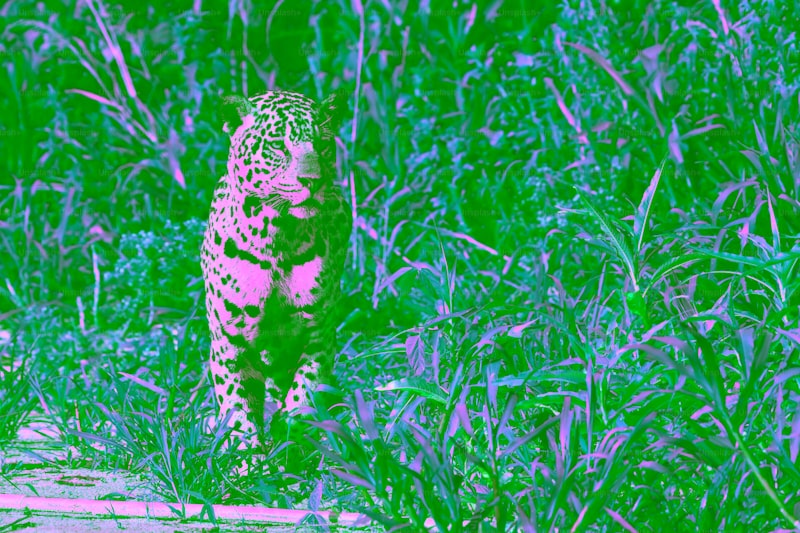Imagine a world where invisibility isn’t just for superheroes. In the wild, there exists a fascinating array of creatures that have mastered the art of blending in with their surroundings—cryptic animals. These masters of camouflage have evolved unique adaptations that allow them to evade predators or sneak up on unsuspecting prey.

Take the leaf-tailed gecko, for instance. Found in the dense forests of Madagascar and Australia, this reptile sports a body that mimics the texture and color of tree bark. Its skin even has ridges and bumps that mimic the irregular surface of a branch, making it nearly impossible to spot against a tree trunk.
Another remarkable example is the walking stick insect. Resembling a twig with legs, these insects are found worldwide in forests and grasslands. Some species even sway gently as they walk, mimicking the movement of a twig blowing in the wind. This clever adaptation helps them avoid hungry birds and other predators looking for an easy meal.
In the depths of the ocean, the mimic octopus takes camouflage to a whole new level. This cephalopod can not only change its color to blend in with its surroundings but also mimic the shapes and movements of other marine creatures, such as lionfish or sea snakes. This extraordinary ability not only helps it evade predators but also allows it to sneak up on prey unsuspectingly.
Even the humble flounder, found in coastal waters around the world, demonstrates incredible camouflage skills. With both eyes on one side of its flat body, it lies on the ocean floor, perfectly blending in with the sandy or rocky bottom. Its ability to change color and texture further aids its disguise, making it nearly invisible to passing predators and prey alike.
Unseen Predators: How Cryptic Animals Use Camouflage to Hunt
Imagine a jaguar, its rosette-patterned coat morphing into the dappled shadows of the rainforest floor. Motionless, it waits patiently, hidden from view, until the perfect moment to strike. Its prey, unaware of the danger lurking nearby, ventures closer, unaware of the lurking danger. In a sudden burst of speed and precision, the jaguar pounces, its camouflage rendering it nearly invisible until the last moment.
Cryptic animals are not limited to the jaguar alone. Consider the mantis shrimp, its body adorned with colors and patterns that mimic the vibrant coral reefs it calls home. This stealthy predator lies in wait, its camouflage fooling both prey and potential predators alike. In a flash of speed faster than the human eye can follow, the mantis shrimp strikes, its prey ensnared before it even realizes the danger.
Nature’s camouflage artists extend beyond the realms of the rainforest and coral reefs. In the icy expanses of the Arctic, the Arctic fox dons a winter coat that blends flawlessly with the snowy landscape. With each step, it moves silently towards its next meal, harnessing the power of invisibility to survive in one of the harshest environments on Earth.
What lessons can we learn from these cryptic hunters? Their mastery of camouflage goes beyond survival; it underscores the importance of adaptability and patience. Just as these animals patiently wait for the opportune moment to strike, so too must we sometimes embrace patience in our own endeavors. And like their ability to blend seamlessly into their surroundings, we can strive for a deeper understanding of our environment and how best to navigate it.
In the world of unseen predators, camouflage isn’t just a defense mechanism – it’s a sophisticated tool for survival and success. As we marvel at the wonders of nature’s cryptic hunters, let us also reflect on the hidden potentials within ourselves, waiting to be discovered and unleashed.
Nature’s Invisible Guardians: Cryptic Animals and Their Survival Tactics
In the intricate tapestry of nature, some creatures have evolved remarkable survival tactics that make them nearly invisible to predators and prey alike. These cryptic animals have mastered the art of blending seamlessly into their surroundings, employing a variety of strategies to evade detection and ensure their survival.
Take the leaf-tailed gecko, for instance. Found in the dense rainforests of Madagascar, its flattened body and mottled skin mimic the appearance of tree bark. When perched on a branch, it becomes indistinguishable from the bark itself, effectively camouflaging against the backdrop of the forest. This natural disguise not only helps the gecko avoid predators but also enables it to ambush unsuspecting insects that wander too close.
Another master of camouflage is the octopus, known for its ability to change both color and texture to match its environment. Using specialized cells called chromatophores, the octopus can instantly blend into the coral reefs or sandy ocean floors where it resides. This adaptive camouflage allows it to hunt for prey undetected and to hide from larger predators such as sharks and seals.
In the insect world, the walking stick is a prime example of cryptic adaptation. Resembling a twig or a small branch, these insects rely on their elongated bodies and slow movements to evade detection. Some species even sway gently in the wind to mimic the natural motion of branches, further enhancing their disguise. This remarkable mimicry not only aids in avoiding predators but also in surprising prey by launching a sudden attack.
Cryptic animals demonstrate nature’s ingenious solutions to survival challenges. Their ability to blend seamlessly into their surroundings showcases evolution at its finest, where subtle adaptations over millions of years have honed these creatures into masters of disguise. Whether it’s through mimicry, camouflage, or adaptive coloration, these invisible guardians of nature continue to fascinate and inspire with their extraordinary survival tactics.
The Art of Disguise: Cryptic Animals That Mimic Their Environment Perfectly
Imagine walking through a dense forest and suddenly realizing that what you thought was a dead leaf is actually a butterfly with wings that mimic autumn foliage. This is precisely the kind of disguise that cryptic animals employ to evade predators or sneak up on prey. They don’t just blend in; they become one with their environment.
One of the most iconic examples of cryptic animals is the leaf-tailed gecko. Found in Madagascar, these geckos have evolved to have bodies that look exactly like tree bark, complete with veins and lichen-like patches. When they rest on branches during the day, they are virtually indistinguishable from the bark itself. It’s nature’s way of saying, “I’m here, but you can’t see me.”
Another master of disguise is the stick insect, known for its remarkable resemblance to twigs and branches. Some species even sway gently as they walk, mimicking the movement of leaves or twigs blowing in the wind. Imagine the surprise of a predator that grabs what it thinks is a twig, only to realize too late that it’s actually a well-camouflaged insect!
Underwater, the leafy sea dragon takes camouflage to a whole new level. Found off the coast of Australia, these creatures have leaf-like appendages all over their bodies, making them look like drifting pieces of seaweed. They blend in perfectly with the kelp beds where they live, making them incredibly difficult to spot.
Nature’s ability to create such perfect disguises is not just a survival strategy but also a testament to millions of years of evolution. It’s as if these animals have unlocked the secrets of invisibility, using color, texture, and even behavior to disappear into their surroundings seamlessly.
Next time you’re out in nature, take a closer look around you. That fallen leaf on the ground or that oddly shaped twig might just be a cleverly disguised creature playing the ultimate game of hide-and-seek.
Masters of Adaptation: How Cryptic Animals Evolved Their Camouflage Abilities

Imagine a world where survival depends on being invisible. Cryptic animals have perfected the art of blending into their surroundings, making them nearly undetectable to predators and prey alike. From the leaf-tailed geckos of Madagascar to the orchid mantises of Southeast Asia, nature has crafted these creatures into living illusions.
One of the most striking examples of camouflage is seen in the leafy sea dragon, a relative of the seahorse found off the coast of Australia. Resembling a piece of drifting seaweed, it uses its leaf-like appendages to mimic the swaying kelp beds where it resides. This disguise not only helps it evade predators but also allows it to sneak up on unsuspecting prey.
Another marvel of adaptation is the snow leopard, native to the mountain ranges of Central and South Asia. Its thick, smoky-gray fur is dotted with dark rosettes, providing excellent camouflage in the rocky terrain and snowy landscapes where it hunts. This elusive big cat is a master of stealth, stalking its prey with unmatched precision.
But how do these animals achieve such perfect camouflage? Evolution has sculpted their appearances over millennia, favoring those with traits that increase their chances of survival. Natural selection plays a crucial role, as animals with better camouflage are more likely to survive and reproduce, passing on their advantageous traits to future generations.
Consider the pygmy seahorse, which inhabits coral reefs in the Pacific Ocean. Measuring just over an inch long, it matches the color and texture of the coral polyps where it lives. Its tiny size and cryptic appearance make it nearly invisible to predators, allowing it to thrive in its vibrant underwater habitat.
Frequently Asked Questions
How do predators and prey interact with cryptic animals?
Learn how predators and prey interact with cryptic animals, exploring the strategies cryptic animals use to evade detection and how predators adapt to overcome these defenses. Understand the dynamics of camouflage, mimicry, and detection in natural ecosystems.
How do cryptic animals use camouflage for survival?
Learn how cryptic animals utilize camouflage techniques to enhance survival in their natural habitats. Discover insights into the adaptive strategies these animals employ to blend seamlessly into their surroundings, evading predators and enhancing their chances of prey capture.
Examples of cryptic animals and their camouflage strategies?
Discover how cryptic animals utilize camouflage strategies to blend seamlessly into their environments. Explore examples showcasing how diverse species adapt colors, patterns, and behaviors to evade predators or ambush prey.
What are cryptic animals and how do they camouflage?
Cryptic animals are creatures that use camouflage to blend into their surroundings, making them difficult to detect by predators or prey. They achieve this through various adaptations such as coloration, patterns, and even behavioral mimicry. This natural camouflage helps them evade detection and enhances their survival in their respective habitats.
How does climate and environment affect cryptic animal camouflage?
This FAQ provides a concise explanation of how climate and environment influence cryptic animal camouflage. It focuses on how coloration and patterns in animals help them blend into their surroundings for survival. The FAQ explores how factors like vegetation, terrain, and seasonal changes shape the evolution of camouflage strategies in different environments.


